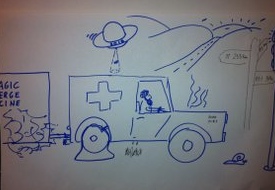As one of the early adopters who applied retrospective techniques to Agile Teams, I coined the term “Heartbeat” retrospectives to reflect the rapid and iterative approach to problems solving that agile teams embrace.

Having being a member of several high performing teams struggling with the weight of success, I know first hand how important it is to teach tools for open, honest and constructive conversations.
While there are many simple retrospective techniques, it’s important that teams look beyond just asking the questions:
- what worked well
- what needs improvement
- what actions will we take
Following this routine by rote, can ultimately negate the usefulness of taking the time to retrospect.
When I work with groups, I show them a variety of different exercises, but also teach them the more important skill of taking responsibility for their actions. It’s crucial to have critical and timely conversations with each other, but it’s equally important to practice giving and receiving good feedback.
The strongest teams not only develop excellent products (which may not always be software) - they also develop strong communication and feedback mechanisms that allow them to spot untapped opportunities. In fact, looking to the future with techniques like futurespectives and appreciate inquiry can also be powerful drivers for innovation in teams.
In technical circles, developers aren’t renowned for their emotional intelligence - but with guidance, and practice they do debunk this myth.